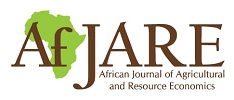All Articles
- All
- Special Issue
- Volume 13-1
- Volume 13-2
- Volume 13-3
- Volume 14-1
- Volume 14-2
- Volume 14-3
- Volume 14-4
- Volume 15-1 (March 2020)
- Volume 15-2 (June 2020)
- Volume 15-3 (September 2020)
- Volume 15-4 (December 2020)
- Volume 16-1 (March 2021)
- Volume 16-2 (June 2021)
- Volume 16-3 (September 2021)
- Volume 16-4 (December 2021)
- Volume 17-1 (March 2022)
- Volume 17-2 (June 2022)
- Volume 17-3 (September 2022)
- Volume 17-4 (December 2022)
- Volume 18-1
- Volume 18-2 (June 2023)
- Volume 18-3
- Volume 19-1
- Volume 19-2
- Volume 19-3
- Volume 19-4
- Volume 20-1
- Volume 20-2
- Volume 20-3
- Volume 20-4
- Volume 8-1
- Volume 8-3
Three experiments were conducted from 2014 to 2018 to examine the economics of yellow passion fruit production under different soil fertility management. In 2014, two yellow passion fruit genotypes, that is Conventional and KPF 4, were grown in the field and pot simultaneously under varying rates of poultry manure (PM), including 0, 10, 20, 30 and 40 t/ha.
This paper conducts ex-ante impact assessments for policy interventions to promote amaranth value chains in Tanzania and Kenya. Amaranth is an underdeveloped, drought-resistant, and nutrition-rich crop used for human food, animal fodder, and ornamental purposes.
This paper assesses the differences in technical efficiency of, and the cassava production systems employed by, male-managed (MMF) and female-managed (FMF) cassava farms in the Fanteakwa District of Ghana.
This study attempted to identify determinants of farmers’ maximum willingness to pay (WTP) for improved use of irrigation water.
We look at the prioritisation of agricultural value chains (VCs) for the allocation of R&D resources that maximise development outcomes (poverty, growth, jobs and diets) in Senegal.
Climate variability threatens farmers’ livelihoods. Efforts to address climate stress recognise climate-smart agriculture (CSA) as a promising approach to minimising the damage caused by increasing weather variability.
Cette étude analyse l’efficacité des producteurs de riz dans l’allocation des ressources dont ils disposent pour la production en recueillant des données transversales auprès de 255 producteurs dans le Centre-Ouest de la Côte d’Ivoire.
This study applied stochastic frontier analysis (SFA) and data envelopment analysis (DEA) to examine the technical efficiency of maize production in northern Ghana using cross-sectional data from 360 maize farmers for the 2011/2012 cropping season.
Smallholder farmers face considerable risk and uncertainty, particularly when markets are incomplete or missing. We consider household crop diversity and crop choice in Zimbabwe, where output markets are largely absent and price signals are inaccurate.
Climate change and heat stress are expected to worsen the issue of water scarcity that is affecting the agricultural sector, among others through increased crop prices and costs, in addition to changes in yields.
This study investigates the relationships between financial inclusion, gender and household welfare. We used baseline data collected from a randomised control trial survey of maize farmers in Nigeria and computed multidimensional indices for financial inclusion and farmers’ household welfare.
The objective of this research was to assess the effects of non-timber forest products (NTFPs) on food consumption expenditure by agricultural households in the southwestern region of Burkina Faso.
Cette étude explore l’effet de l’intégration des pays africains aux chaînes de valeur agricoles sur la sécurité alimentaire, en soulignant le rôle central des institutions.
Since 2002, a range of South African policies have attempted to address the disproportionate burden of food and nutrition insecurity on the population. Yet malnutrition among the poor has worsened.
Sub-Saharan African countries, with their initially large agricultural sectors, reduce poverty and urbanise most rapidly and efficiently when they achieve rapid agricultural growth.2 The faster agriculture grows, the faster its relative importance declines.
This study empirically investigates the effect of the productive safety net programme (PSNP) on household food consumption and dietary diversity in Ethiopia. The study applied random effects with instrumental variables to estimate the effect of PSNP membership.
In sub-Saharan Africa, identifying estimates of consumers’ preferences and willingness to pay (WTP) for safe food continues to receive attention in the literature. Using experimental data from Nigeria, we examined the source of heterogeneities in preference and WTP for organically produced food.
This paper examines farmers’ preferences for an improved Bambara groundnut variety, the key attributes desired, factors influencing preference, and the number of attributes desired by smallholder farmers in Ghana.
This is a special issue of the African Journal of Agricultural and Resource Economics (AfJARE), with papers contributed by the faculty members of the Collaborative Master’s in Agricultural and Applied Economics (CMAAE), one of the collaborative training programmes of the African Economic Research Consortium (AERC).
Accessing water supply services remains a serious challenge in Wakiso District in Uganda, where most households travel long distances to collect water – a process that threatens their health, productivity and economic wellbeing.
Potato (Solanum tuberosum L.) is known for its efficiency in converting resources into high-quality food, which can aid in poverty reduction. However, the potato yield in Rwanda has been declining, leading to farmer dissatisfaction with trading terms and a reliance on low prices in the value chain.
The impact of women’s empowerment in agriculture on women\s health, indicated by their body mass index (BMI), is examined using an instrumental variable estimation approach on a sample of 4 267 women.
Using an original database from French archives on French trade statistics, this article undertakes a comprehensive study of the nature and dynamic of French sectoral trade for the period 1880 to 1912.
Agricultural digitisation is one of the key drivers of agricultural development, as well as of rapid economic growth, in many countries. This study aims to investigate the causal links between agricultural digitisation and high-quality agricultural development in the context of developed and developing countries.
